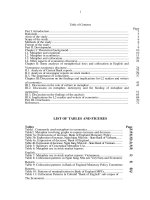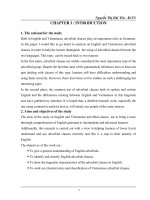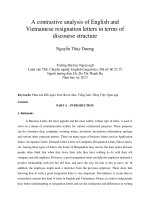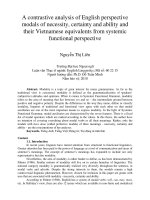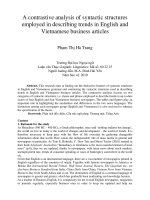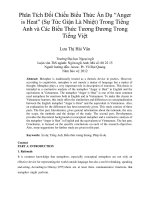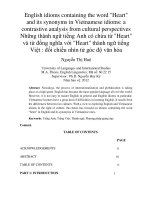A contrastive analysis on selected english and vietnamese dog related idioms
Bạn đang xem bản rút gọn của tài liệu. Xem và tải ngay bản đầy đủ của tài liệu tại đây (902.39 KB, 67 trang )
HANOI PEDAGOGICAL UNIVERSITY 2
FACULTY OF FOREIGN LANGUAGE
----------------------
NGUYEN THI TRUNG ANH
A CONTRASTIVE ANALYSIS ON SELECTED ENGLISH
AND VIETNAMESE DOG-RELATED IDIOMS
Major: English Language Teaching
Ha Noi, 2019
HANOI PEDAGOGICAL UNIVERSITY 2
FACULTY OF FOREIGN LANGUAGE
----------------------
NGUYEN THI TRUNG ANH
A CONTRASTIVE ANALYSIS ON SELECTED ENGLISH
AND VIETNAMESE DOG-RELATED IDIOMS
Major: English Language Teaching
Supervisor: Pham Thi Tuan
Ha Noi, 2019
ACKNOWLEDGEMENTS
I would love to show profound gratitude to my supervisor, Ms. Pham Thi
Tuan, for her dedicated and scholarly instructions, wholehearted guidance, critical
comment, great encouragement and valuable materials that she gave me while I was
doing in research. Without these, the thesis could not have been completed.
I wish to express my sincere thanks Mr. William Salazar for his dedicated
instructions and reminding in time during months of my graduation paper.
Last but not least, I owe a debt of gratitude to my beloved family and friends
for their support and love, which were extremely important for the completion of
this paper.
Student
ii
ABSTRACT
Idioms can be found in every language and in all types of discourse, ranging
from daily conversations to scientific texts. Hence, it is indispensable for language
learners to know what idioms are and how they are related within and among
languages. This study was aimed to investigate the similarities and differences
between English and Vietnamese idioms containing the word „dog‟. Contrastive
analysis and content analysis were used to analyze and discuss 110 selected dogrelated Vietnamese and English idioms in both syntactic and semantic features. The
results revealed that dog-related English and Vietnamese idioms greatly differ in
terms of syntactic structures, namely noun phrases, verb phrases, adjective phrases,
preposition phrases, and sentences. While the two most common syntactic
structures for dog-related English idioms are noun phrases and verb phrases,
sentence is the syntactic structure for the majority of Vietnamese ones. As for
semantic features, dog-related idioms in these two languages; however, share
similarities in positive, negative and neutral connotation, which are particularly
influenced by culture and stylistic devices.
Key words: idiom, dog, syntactic features, semantic features, contrastive
analysis
iii
STATEMENT OF AUTHORSHIP
Tittle:
A CONTRASTIVE ANALYSIS ON SELECTED ENGLISH AND
VIETNAMESE DOG-RELATED IDIOMS
(Graduation paper submitted in partial fulfillment of the Degree of
Bachelor of arts in English)
I certify that no part in this study has not been copied by me from any other
person„s report without acknowledgment and this work is written by my best under
the instruction from my supervisor.
Date of submission: 10th May, 2018.
Student
Supervisor
Nguyen Thi Trung Anh
Pham Thi Tuan
iv
LIST OF THE TABLES AND FIGURES
Tables:
Table 1
Classification of idioms in syntactic features
Table 2
Classification of idioms in semantic features
Table 3
Structures of selected English dog-related idioms
Table 4
Structures of selected Vietnamese dog-related idioms
Table 5
Syntactic features of selected English and Vietnamese dog-related
idioms
Table 6
Semantic features of selected English and Vietnamese dog-related
idioms
Figures:
Figure 1
Selected English and Vietnamese dog-related idiom structures
v
TABLE OF CONTENTS
ACKNOWLEDGEMENTS ......................................................................................ii
ABSTRACT ............................................................................................................. iii
STATEMENT OF AUTHORSHIP ........................................................................ iv
LIST OF THE TABLES AND FIGURES .............................................................. v
PART ONE: INTRODUCTION ....................................................................... 1
1. Rationale........................................................................................................ 1
2. Significance of the study ............................................................................... 2
3. Scope of the study ......................................................................................... 2
4. Aims of the study and Research questions ................................................... 3
5. Research methods.......................................................................................... 3
6. Design of the study........................................................................................ 3
PART TWO: DEVELOPMENT ....................................................................... 5
Chapter 1: LITERATURE REVIEW ......................................................................... 5
Chapter 2: THEORETICAL BACKGROUND ............................................... 6
1. An overview of idioms and dog-related idioms ............................................ 6
1.1. Definition of idioms ................................................................................... 6
1.2. Idioms which are related to dogs ............................................................... 7
1.3. Linguistic features of idioms...................................................................... 7
1.3.1. Syntactic features .................................................................................... 7
1.3.2. Semantic features .................................................................................... 8
1.3.3. Culture features ....................................................................................... 9
2. Classification of idioms............................................................................... 10
2.1. Based on syntactic features ...................................................................... 10
2.2. Based on semantic features ...................................................................... 12
2.3. Idioms in association with culture ........................................................... 13
3. Overview of Phrase, Clause and Sentence Structures ................................ 14
3.1. Phrase ....................................................................................................... 14
3.2. Clause ....................................................................................................... 14
3.3. Sentence ................................................................................................... 15
vi
Chapter 3: METHODOLOGY AND PROCEDURES .................................. 17
1. Research Methods ....................................................................................... 17
2. Research Procedures ................................................................................... 17
3. Description of the Sample ........................................................................... 18
Chapter 4: FINDINGS AND DISCUSSION ................................................. 19
1. Syntactic analysis of selected dog-related idioms in English and
Vietnamese ...................................................................................................... 19
1.1. Idiom structures based on syntactic features ........................................... 19
1.2. Discussion of similarities and differences in Syntactic features of selected
English and Vietnamese dog-related idioms................................................... 24
1.2.1. Similarities in Syntactic features of selected English and Vietnamese
dog-related idioms .......................................................................................... 28
1.2.2. Differences in Syntactic features of selected English and Vietnamese
dog-related idioms .......................................................................................... 29
2. Semantic analysis of selected dog-related idioms in English and
Vietnamese ...................................................................................................... 32
2.1. Meaning colors of selected English and Vietnamese dog-related idioms 32
2.1.1. Meaning colors of English dog-related idioms ..................................... 32
2.1.2. Meaning colors of selected Vietnamese dog-related idioms ................ 34
2.2. Discussion of similarities and differences in Semantic features of selected
English and Vietnamese dog-related idioms................................................... 35
2.2.1. Similarities in Semantic features of selected English and Vietnamese
dog-related idioms .......................................................................................... 37
2.2.2. Differences in Semantic features of selected English and Vietnamese
dog-related idioms .......................................................................................... 39
3. Cultural factors behind English and Vietnamese idioms concerning dogs 41
5. Difficulties in learning idioms concerning dogs and suggested solutions .. 42
5.1. Difficulties of learning idioms related to dogs ........................................ 43
5.1.1. Idioms are not literal ............................................................................. 43
5.1.2. Dog-related idioms has complex structures ......................................... 43
5.1.3. It’s difficult to use idioms correctively .................................................. 43
5.1.4. Teaching materials are not much available.......................................... 43
vii
5.2. Suggested solutions .................................................................................. 44
5.2.1. Learn idioms in context, never in isolation ........................................... 44
5.2.2. Create conversation using idioms ......................................................... 44
5.2.3. Themes: Related to your topic .............................................................. 45
5.2.4. Always study about culture ................................................................... 45
PART THREE: CONCLUSION ..................................................................... 46
1. Major findings ............................................................................................. 46
2. Limitation of the study and suggestions for further research ..................... 47
REFERENCES ................................................................................................ 48
APPENDIX 1 .................................................................................................. 50
APPENDIX 2 .................................................................................................. 55
viii
PART ONE: INTRODUCTION
1. Rationale
A quite long time ago, human being used numerous forms of language to
convey their messages with one another and show the cultural identity of the
country. Meanwhile, with the development of the 21st century society, people are in
high demand for learning languages to interchange such a lot of fields as economy,
education, service, etc. Therefore, English has increasingly become much more
necessary but quite struggling for learners to understand the words.
In daily conversations, communicators may encounter odd and
puzzling phrases or expressions whose meanings are different from what their
components convey. This challenge lies in the complicated, strange yet captivating
nature of idioms owing to such cultural identity of different countries as history,
religions, tradition, etc. (Grunwell, 1998 & Yagiz, 2013). To English learners, if
they desire to reach the ultimate goal in communicating as native speakers, they
need to pay attention to the idioms as well.
Idioms are appeared in every single material surrounded us. It can be in
“newspapers, books, magazines, on the radio, on the television, in everyday
conversation, and at work.” Besides, what the world‟s perceptions and viewpoints
about things in human and animal existence between English and Vietnamese is
quite different and leads most of the idioms not the same. Expressions in this way
bear the cultural characteristics of a country in which they are used. Therefore, to
understand as well as translate idioms from a language into another one, knowledge
of not only linguistic aspects but also of cultural reality has to be involved.
Finding idioms exciting and compelling for quite a long time, I would like to
take this chance to achieve deep insight into both English and Vietnamese idioms.
As a matter of fact, a wide variety of studies and investigations into idioms have
been done so far which mainly concern love, family, colors, body parts, animals,
plants, etc. With limited time, this study focuses on a tiny part of the whole
immense idiom treasure – English and Vietnamese idioms related to dogs.
Furthermore, I personally find dog-related idioms fascinating to learn and use and
there has been no study of idioms related to dogs in a range of Hanoi Pedagogical
University Number 2.
1
Hopefully, this analysis can be helpful, to a certain extent, for learners to
understand the fundamental nature of dog-related idioms in both languages and how
to use them practically. It can also contribute a bit to the teaching and learning as a
second language in Vietnam, particularly in Hanoi Pedagogical University 2.
2. Significance of the study
Idioms are plentiful in both English and Vietnamese, and there are numerous
aspects to investigate regarding idioms. It is undeniable that idioms concerning
animals account for a significant proportion of both English and Vietnamese idiom
system, especially dogs, are the most frequently mentioned animal in English
idioms (Ruhanen, 2015).
However, to what extent, it is easier to find out how to learn idioms in
foreign languages if having clear understanding in similarities and differences
between them. I used to encounter it when I study English and then took notes all of
them so that they now are sources in this paper to help language learner deal with.
To be equal and have the best general look at both languages, and I choose the same
number of dog-related idioms. Therefore, the study is considered a dog-mentioned
idiom dictionary for learners to study effectively and use them correctly.
3. Scope of the study
During doing this research, all the idioms are carefully selected from official
resources and specialized idiom dictionaries such as American Idioms Dictionary,
English Idioms Dictionary, and Từ điển Thành ngữ Tiếng Việt based on their
convention and system. Throughout the process of finding and filtering idioms,
there is a significant number of selected idioms about dogs including 55 idioms in
Vietnamese and 55 idioms in English.
In this study, only dog-related idioms are selected to make a contrastive
analysis of English and Vietnamese idioms about dogs. “It is a contrastive analysis
focusing on terms of syntactic and semantic aspects. Syntactically, my study will
investigate into account of dogs with noun phrase structure, verb phrase structure,
adjective phrase structure, prepositional phrase structure, and sentence structure. In
the aspect of semantic opacity, an investigation into Positive connotation, Negative
connotation, and Neutral connotation will be carried out.”
2
4. Aims of the study and Research questions
4.1. Aims of the study
This study is carried out with the hope to identify the similarities and
differences between English and Vietnamese dog-related idioms regarding semantic
features and syntactic features to help people to be master in learning English and
Vietnamese. In addition, learners are able to imply the beauty of a foreign language
and its social features.
4.2. Research questions:
The study is to answer the following questions:
1. What are the similarities in syntactic and semantic features of selected
English and Vietnamese idioms concerning dogs?
2. What are the differences in syntactic and semantic features of selected
English and Vietnamese idioms regarding dogs?
5. Research methods
This research was conducted with the use of contrastive analysis and content
analysis method. They are research methods that analyze “the differences and
similarities of two or more languages (or subsystem languages) are made explicit”,
more specific it is English and Vietnamese. I based on database analysis form
resources of material both on the Internet and my supervisor.
“An explicit analysis is a way of comparing the forms (phonemes,
morphemes, syntax, etc.) of first language and a second language to find out how
far or close the structures of the two languages are. In this case, the primary
language is English and the second one is Vietnamese and the features of syntactic
and semantic.”
6. Design of the study
For a transparent organization, my graduation paper is divided into three
main parts in which the second is the most important part:
- Part 1 is entitled the “Introduction” where rationale, significance, scope,
aims and research questions, research methods and design of the thesis are
presented.
- Part 2 is the “Development” which consists of three chapters:
3
+ Chapter 1: Theoretical Background, including small parts presenting the
definitions of idioms; principal features of idioms: syntactic and semantic and
culture features; and overview of phrase, clause and sentence structures
+ Chapter 2: Methodology and Procedure, dealing with research design,
research methods, research procedures, description of the sample, data
collection, reliability and validity.
+ Chapter 3: Findings and discussion, presenting the data analysis and
discussion on the similarities and differences of dog-related English and
Vietnamese idioms in terms of syntactic and semantic features.
- Part 3 is the “Conclusion” to perform summary of the study, limitation of
the study and suggestions for further studies
4
PART TWO: DEVELOPMENT
Chapter 1: LITERATURE REVIEW
In fact, idiomaticity is not a new subject in linguistic study. There has been
plenty of work on it such as “Essential Idioms in English” by Dixon, R. J. [17], or
“Idioms for Everyday Use” by Broukai, M. [6]…
Vietnamese idioms also prove significant in Vietnamese language, and
several native linguists have been trying to collect them and to detect their special
peculiarities. The pioneers are Nguyễn Lực and Lương Văn Đang [63]. Lately,
Nguyễn Lực has just produced an important and useful book “Thành ngữ tiếng
Việt” [64]. More interestingly, there have been a lot of contrastive studies on idioms
in Vietnamese and other languages such as English, French, Russian… by Nguyễn
Đình Hùng [60], Bùi Phụng [67]. Furthermore, a number of contrastive studies on
the various aspects of idioms have been carried out in many universities and
colleges across Vietnam. For example, in Danang University, there are “An
investigation into syntactic, semantic and cultural features of idioms denoting life
and death in English and Vietnamese” by Nguyễn Hoàng Trà My [25]; “A
Contrastive Analysis of English and Vietnamese Idioms Using the Terms of Human
Body Parts” by Nguyễn Thị Hiệp [31]… It can be seen researches on such terms as
plants, time, happiness but none of term of dog.
To be clearer, there has been thesis in Hanoi Pedagogical University 2
involved in dogs. Based on many interviews second language learners, the obstacle
they feel hard to overcome most is studying idioms. Therefore, this paper is
necessarily fulfilled in the university library and may be small dictionary for whom
wants to look up the idioms‟ meanings and find the approach to be better.
5
Chapter 2: THEORETICAL BACKGROUND
1. An overview of idioms and dog-related idioms
1.1. Definition of idioms
As a peculiar part of the language, idioms have drawn so much attention
from linguists globally that numerous research has been conducted to investigate
their basic nature, characteristics and varieties from various approaches. However,
the concept of idioms has remained controversial in the field of language, leading to
no agreed definition of idioms among linguistic scholars.
First and foremost, defined by the Oxford Advanced Learners‟ Dictionary
(2006), idioms are “a phrase or sentence whose meaning is not clear from the
meaning of its every single words and which must be learnt as a whole unit”. For
example, the idiom “under the weather” refers to the state of being slightly unwell
or in low spirits, which means that it is impossible to understand this idiom by
merely knowing the meaning of its components – “under” and “weather”. Likewise,
on the ground of semantics, O‟Grady (1998) stated that what idioms truly convey is
a more complicated interpretation of its components. In a similar vein, Adkins
(1968) provided a more specific explanation that idioms, known as phraseological
unit, are a stable multi-word group whose meaning is entirely or partially
transferred. In other words, as assumed by Fotovatnia and Goudarzi (2014), idioms
in the form of fixed expression convey meaning in a non-literal or metaphorical
way.
Another concept of idioms provided by Johnson (1993) is that “If natural
language had been designed by a logician, idioms would not exist” (Khosravi &
Khatib, 2012, p.274). That is to say, the real meaning of an idiom cannot be
logically deduced from its elements.
In Vietnamese, idioms are generally considered “thành ngữ”, “nhóm ngữ
cú”, or “cụm từ cố định”. According to another concept of idioms given out by
Nguyen (2010), idioms are viewed as groups of words which are restricted in syntax
and often convey imaginative and figurative meanings. Hanh (2002) mentioned
idioms in “Kể chuyện Thành ngữ, Tục ngữ” as a set expressions stable in structure,
figurative in connotation and used mainly in daily discourse.
6
In a nutshell, despite minor differences in aspects among concepts of idioms
previously mentioned, idioms can be generally considered as fixed word groups
whose meaning is not deducible from the meaning of individual constituents.
1.2. Idioms which are related to dogs
Although the origin of the domestic dog is not clear, it is known that the dog
was the first domesticated species and has a very close-knit relationship with human
beings. Thanks to the dogs‟ senses include vision, hearing, sense of smell, sense of
taste, touch and sensitivity to the earth's magnetic field, and they make lots of
efforts in helping people such activities as hunting, protection, assisting police and
making as friends.
English idioms were classified into several special groups including
numbers, time, body parts, animals and briefly listed by Seidl & Mordie (1993) in
“Pocket English Idioms”. According to them, dog-related idiom is a special kind in
which dog elements with special meanings are considered vital words. In other
words, dog-related idioms are one specific group of idioms that demonstrate the
way each person using in set expressions and how they associate these terms with
other things in the world.
1.3. Linguistic features of idioms
Existing in most languages, idioms have long posed long-lasting challenges
for linguistic scholars to figure out typical characteristics of idioms. As a matter of
fact, tremendous efforts in this field have been made among researchers. According
to Carter (1997), features can be summarized based on two major grounds: syntactic
and semantic peculiarities.
1.3.1. Syntactic features
“Syntactic” refers to “the way that words and phrases are put together to
form sentences in a language” (Cambridge Advanced Learners‟ Dictionary).
Regarding syntax of idioms; inflexibility, fixedness and invariability are frequently
used words by linguists to describe the nature of idioms.
First of all, it is impossible to replace any individual element of idioms;
otherwise, there will be loss of idiomatic meaning. For instance, the idiom “cup of
tea” refers to something you are interested, you are good at, or you enjoy doing;
however “glass of tea” would not create any idiomatic expression though glass and
cup are near synonyms. It is this feature that makes idioms truly distinct from other
7
lexical units because, in daily discourse, replacement of words within structures is
so common to convey similar ideas.
Secondly, introducing any additional constituent into idioms‟ structures is
not allowed. That is to say, idioms are regarded as whole chunks, nearly equivalent
to a single word (Cacciari and Tabossi, 1988). An example can be “like two peas in
a pod” which means two things bear a very close resemblance. The idiom‟s real
meaning will be broken or distorted if a component is added into the structure like
“like two small peas in a pod” or “like two green peas in a pod”.
The third restriction that should be considered when using idioms is
grammatical invariability. For example, for the idiom “pull someone‟s leg” (make
fun of someone), it is possible to say “He always pulls my leg” or “He pulled my
leg whenever he met me”. However, the idiomatic meaning will not be delivered if
we add plural forms: “pull my legs” or an article: “pull the leg”. Moreover, while
passivization is a common phenomenon in English to retain the same sense, it is not
applied for the case of idioms. Take idiom “spill the beans” as an example. It can be
seen that in the passive voice, “beans are spilled” may make literal sense in some
certain context but it fails to retain idiomatic connotation of the original idiom.
Another noteworthy feature of idioms is that they can bear regular structures
or grammatically incorrect ones (Holsinger, 2013). Considering the first group,
some idioms have correct grammatical structures like “You can‟t teach an old dog
new tricks” or “It‟s not just a day”. Meanwhile, others have unconventional forms.
“Through thick and thin” is a typical illustration for illogical and irregular
grammatical forms. According to the rule of language, the preposition “through”
must be followed by a noun, a noun phrase or a gerund, but “thick and thin” in this
idiom is an adjective phrase.
1.3.2. Semantic features
Semantics, rooted from Greek verb “Semainein” meaning “to signify”, is an
aspect of linguistics dealing with the meaning of words and sentences (Oxford
Advanced Learner‟s Dictionary).
The degree of meaning transference of idioms may be varied at different
levels because some idioms are “semantically opaque” (Langlotz, 2006, p.2) while
others are relatively transparent. With the same viewpoint, Coulson (2001) referred
to two terms which are non-compositional and partly-compositional idioms.
8
In non-compositional idioms, the whole group undergoes meaning
transference and there is no relation between the surface sense of words and the true
meaning of idioms. A wide variety of idioms can be taken as examples for this like
“dark horse” (a little known person who keeps their abilities secret and suddenly
surprises others with unexpected success), “have one‟s heart on one‟s sleeve”
(openly show one‟s feelings rather than keeping them hidden) or “anh hùng rơm” in
Vietnamese (a person who always tries to show off his incredible characteristics
like a hero, but it is not true in reality). They are considered higher idiomatic
expressions since their meanings are not related to meaning of individual elements.
Meanwhile, some idioms are regarded partly-compositional because literal
meaning of one or some components is still preserved so that the meaning of the
whole expression can somehow be guessed. For instance, “fall in love” (to be
suddenly and strongly attracted to someone) or “lose someone‟s temper” (become
angry at somebody or something).
Furthermore, sematic characteristics of idioms are under tremendous
influence of cultural factors which clearly reflect how people perceive and view the
world. That‟s why it is of significant importance for learners to figure out hidden
connotation of idioms “by summoning knowledge of cultural peculiarity as well as
personal life experience since idioms are closely related to the culture of the country
that they belong to.”
1.3.3. Culture features
Based on the Merriam-Webster dictionary, an idiom is defined that it
expresses the meanings cannot be grasped from “its separate words but has a
separate meaning of its own.” In other words, idioms should not be taken literally.
People use them in order to communicate to others and interchange their thoughts
and feelings in a various way. “To understand idioms you have to know the culture
that is behind them, or at least their origin. We can say that understanding idioms is
like being “in over one‟s head”, meaning it is something difficult to do.”
It is not vague that idioms brings cultural aspects to the language. They
themselves in particular and words in general closely associate with historical
background, economy, geographical environment, custom and innermost spirit. For
example, there an idiom in Venezuela, “al mal tiempo, buena cara” which can be
9
word by word translated to “during bad times, put on a good face”. The English
“idiom equivalent” would be “seeing through rose-tinted glasses”.
“It is the totality of human experience acquired during transmission of
heritage from one generation to another and to learn the ways of learning, eating,
drinking, behaving, walking, dressing, and working is the culture of man.”
“From a dynamic view, language and culture interact with each other and
shape each other. Language is the carrier of culture which in turn is the content of
language.” “Idioms as a special form of language exist in both of them and carry a
large amount of cultural information such as history, geography, religion, custom,
nationality psychology, thought pattern…, and therefore are closely related to
culture. Consequently, we can know much about culture through studying idioms
and in turn get better understanding of idioms by learning the cultural background
behind them.”
2. Classification of idioms
It can be seen that it is absolutely crucial to systematize idioms for better
learning and studying process. In fact, different linguists and researchers always
have their own ways to classify idioms, leading to various criteria for grouping
them. The oldest principle for sorting idioms mentioned by Nguyen (1995), also
widely known as “thematic” categorization, is based on varied themes of idioms.
Nevertheless, as he stated, this method does not cover important linguistic
characteristics of idioms. Due to the fact that form numerous approached, the
understanding of idioms‟ nature by linguistic scholars can significantly vary; it is
beyond the realms of possibility to cover all grounds of sorting idioms. Hence, the
thesis only focuses on two basic criteria of idiom categorization as follow:
Syntactic approach
Semantic approach
2.1. Based on syntactic features
Apart from semantic approach, syntax is also a significant criterion for idiom
grouping. According to Linden (1993), idioms can be sorted into phrasal and
sentence idioms. In other words, phrasal idioms have structures of phrases while
sentence counterparts come in the form of a complete sentence structure. To be
more specific, regarding phrasal idioms, they can come in an extensive range of
constructions.
10
Table 1: Classification of idioms in syntactic features
Examples
Structures
Phrasal idioms
Noun phrase (NP)
A piece of cake, living hand to mouth
Verb phrase (VP)
Make ends meet, stab someone in the
back
Adjective phrase (adj P)
The best of both worlds, as genuine as
a three-dollar bill
Adverbial phrase (adv Now and then, when pigs fly
P)
Preposition phrase (P.P)
Over the moon, up in the air
Let the cat out of the bag; when it
rains, it pours
Sentence
idioms
For Vietnamese idioms, according to the book “Dictionary of Vietnamese
idioms and proverbs” (Nguyen, 2010), idioms can be sorted into four groups as
mentioned below:
Comparison idioms: “mỏng như lá lúa”, “nhẹ tựa lông hồng”, etc.
Idioms with symmetrical structures (idioms with two members which have
the same form or balanced contents opposite or supplement of each other): “được ăn
cả ngã về không”, “ăn chắc, mặc bền”, etc.
Alliteration idioms (idioms with the same letter or sound at the beginning
of adjacent or closely connected words): “dấm dấm dớ dớ”, “đi đi lại lại”, “đi đêm
đi hôm”, etc.
Reduplication idioms (idioms that have all or a part of a word is repeated):
“khúc kha khúc khích”, etc.
In brief, there exist various ways to categorize idioms in both English and
Vietnamese. However, for the purpose of identifying syntactic similarities and
differences of English and Vietnamese idioms, the aspect of grammatical patterns
and structural mechanism will be analyzed in the next chapter.
11
2.2. Based on semantic features
From semantic approach, idioms can be sorted on the degree of
metaphoricity conveyed by these multi-word units from the lowest level to the
highest one. In reality, a wide variety of idiom classifications have been proposed
by numerous linguists. According to Vinogradov (1986), there are three major
groups of idioms from semantic view: phraseological combinations, phraseological
unities and phraseological fusions.
Phraseological combinations
This is the least idiomatic because one of the member words still retains its
literal meanings, making it possible to catch the figurative meaning of the whole
expression partly based on individual elements. For instance, in the idiom “bosom
friends” which means intimate friends, the component “friends” is literal while
“bosom” is used figuratively.
Phraseological unities
The typical feature of this type is that meaning of idioms cannot be deduced
from the total meaning of its components because it undergoes metaphoric or
metonymic transference. However, the real meaning can be inferred from the image
of the whole expression. For example, “turn over a new leaf” or “fish out of water”.
Phraseological fusions
This type of idioms is considered to have the highest degree of semantic
cohesion, which means its meaning is not related to the meaning of its constituent
parts. “Spill the beans” is one of typical illustrations for this. Its connotation is
“reveal someone‟s secret” and has no direct relevance to the literal image. That is to
say, idioms come as an independent part of language and must be comprehended as
a whole.
Besides Vinogradov, other linguists also suggested numerous ways of
categorizing idioms as listed in the following table:
12
Table 2: Classification of idioms in semantic features
Fernando (1996)
Moon (1998)
Yorio (1980)
Grant & Bauer
(2004)
Literal idioms: on “Transparent
“Transparent (not ONCE (only one
foot, rely on
idioms: pack one’s idioms): your face word is non-literal-
“Semi-literal
idioms:
names,
bill”
bags, alarm bells looks familiar”
ring”
“not idioms):
curly issue”
“Semi-transparent
“Figurative
“Semi-transparent:
drop idioms: the pecking shake
foot
the order, grasp the bumper
nettle”
a
hands, expressions: hit the
to nail on the head”
bumper”
Pure idioms: smell Opaque
idioms: “Opaque/True
“Core idioms: by
a rat, under the over the moon, idioms: be on the and large, red
weather
“kick the bucket”
wagon, in the tape”
nutshell”
2.3. Idioms in association with culture
Considered as the mirror of culture, languages clearly reflect how people in
different countries perceive and view the world in different ways. The intimate
relation between language and culture can be described with a metaphor that culture
is the iceberg. The visible part is the language and lying hidden beneath the surface
is the invisible aspect of culture.
As an essential component of a language‟s vocabulary, idioms truly reflect
related-culture factors like history, religion, customs and tradition. Both English and
Vietnamese language in general and idioms in particular have developed with the
long history of the two countries. That‟s why English and Vietnamese idioms not
only carry folk tradition but also represent cultural identities of the two nations. For
example, English people compare strength with a horse –“as strong as horse” while
Vietnamese people believes “as strong as buffalo”. It is cultural factors that can give
a reasonable explanation for this difference. In English with nomadic culture, horse
can carry heavy load, pull carts, plough, transport… which is ideally helpful for
nomadic people to serve for their moving lifestyles. Meanwhile, in Vietnam – an
13
agricultural country, buffalos not horses are a precious property of every farmer
because they are very strong and hard-working to help farmers do heavy tasks in the
field. The example is to demonstrate that what idioms convey is under significant
influence of culture aspect and shaped by cultural view. Therefore, the deeper
learners understand cultures of the two countries, the better they can grasp and use
idioms. This is also an essential factor to take into consideration in analyzing
similar and dissimilar semantic features of dog-related idioms in this study.
3. Overview of Phrase, Clause and Sentence Structures
3.1. Phrase
A phrase, a single unit that words group together is typically an element in a
clause or a sentence. It does not have a subject and verb which is opposite to clause,
as a result could not express a complete thought.
Shirley Temple‟s quotes as some following examples. The phrase italicized
in “I stopped believing in Santa Claus when my mother took me to see him in a
department store, and he asked for my autograph.” “acts like a noun. It is the direct
object of the verb stopped. This phrase is a gerund phrase.”
“This phrase acts like a noun. It is the subject of the adverbial clause when
my mother took me to see him in a department store. I stopped believing in Santa
Claus when my mother took me to see him in a department store, and he asked for
my autograph.”
“I stopped believing in Santa Claus when my mother took me to see him in a
department store, and he asked for my autograph. This phrase acts like a noun. It is
the object of the preposition for.”
“I stopped believing in Santa Claus when my mother took me to see him in a
department store, and he asked for my autograph. This phrase acts like an adverb. It
tells us where the activity took place. It is an adverb of place.”
In this study, I focus on verb, noun, adjective, adverb and prepositional
phrases.
3.2. Clause
A clause includes “a subject and a verb” separated into “independent
clause”, convey “a complete thought and can be a standalone sentence; dependent
14
clause, a supporting part of a sentence and cannot stand by itself as a meaningful
proposition.”
For example:
“When the man broke into the house, the dog barked at him”.
“When the man broke into the house” called “Subordinate clause” because it
contains incomplete idea and needs a main clause “the dog barked at him” to make
a meaningful sentence. In the contrary, “the dog barked at him” is independent
clause since people can grasp it.
Clauses are used in sentence as a variety of roles. Firstly, noun clause is in “I
cannot remember what I said last night.” Secondly, adjective clause is in “My dog,
who usually refuses to go near the water, dived in the canal to chase a water vole.”
Thirdly, abverbial clause is in “He lost his double chin after he gave up beer.”
3.3. Sentence
“A sentence is a set of words that is complete in itself, typically containing a
subject and predicate, conveying a statement, question, exclamation, or command,
and consisting of a main clause and sometimes one or more subordinate clauses.”
“A sentence must have a main clause or more than one main clause. There are as
many clauses as there are finite verbs in a sentence. (The finite verb is the verb that
changes with the person or number of the subject.)”
It is adapted from
/>e a sentence:
Begins with a capital letter and ends with a punctuation.
May be a word or short sentence as statement or question, “used to
express a strong feeling such as surprise, excitement or anger.”
“Can also be a combination of two or more clauses. One of the clauses
must be an independent clause, and the other clause can either be an independent or
a dependent clause. It is important to know about clauses in order to construct
complete sentences.”
“Has two parts: a subject (noun or pronoun) and a predicate (a verb or a
phrase)” and the subject-predicate agreement must be observed
15
Be complete idea that “can stand alone, its meaning is clear, and does
make sense, it is accepted as a sentence.”
“Can be joined to another sentence without the use of a conjunction. We
do it by using the present participle which is the –ing form of a verb: look –
looking.”
“Can be made a negative sentence using –ing form of the verb, we put not
in front of it.”
16
